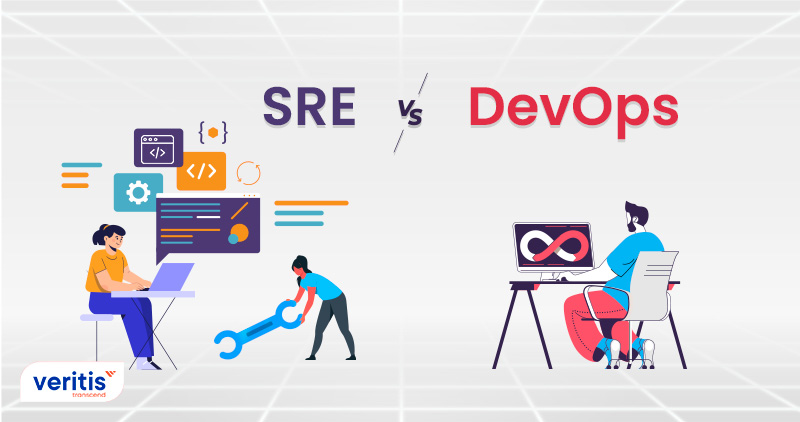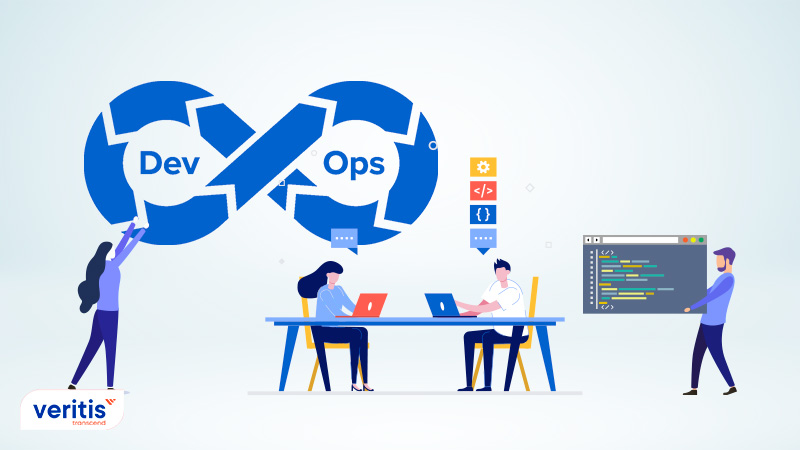
When a new concept emerges in software development, companies are increasingly adopt methodologies that allow dependable and scalable software. For the past few years, two concepts have been trending in the IT arena – DevOps and Site Reliability Engineering (SRE). They both coexisted in the field of software development and deployment.
Both these may appear to be competitors at first glance. However, deep insights revealed that alleged competitors have distinct processes and identities to meet the requisite goals. Moreover, they both are different words for the same approach. Both Site Reliability Engineering (SRE) and DevOps aim to bridge the gap between development and operations teams to improve the life cycle without compromising quality. For past few years, the rise of DevOps and Site Reliability Engineering approaches and practices have become mainstream.
Dynatrace, the software intelligence platform, revealed that 88 percent of SREs respondents expressed their opinion that they know an in-depth understanding of the strategic importance of their role right now than it was three years ago. 99 percent of SREs respondents said they encountered challenges when creating and designing SLOs to evaluate service levels for infrastructure and applications. 85 % of SREs respondents said they need to run the same observability platform from development to operations and security by 2025.
Another survey conducted by Transposit firm on National DevOps day stated that two-thirds of respondents (63 percent) had noticed a rapid growth in service incidents after affecting their clients during the last 14 months. Furthermore, coming to the DevOps workflow, over half of respondents (58 percent) said that downtime for their company could be up to USD 4,99,999 per hour on average, with 40 % informed that the cost increased in the previous year.
Useful link: DevOps Adoption Challenges Businesses Must Overcome
Before delving deep into the significant difference between Site Reliability Engineering (SRE) and DevOps, let’s explore the concepts first.
What is Site Reliability Engineering (SRE)?

The concept of Site Reliability Engineering (SRE) was first originated at Google in 2003 under the direction of Ben Treynor Sloss, vice president and overseeing technical operations at Google. In recent times, SRE has gained much traction in the IT world.
Google’s vice president Treynor Sloss said, “So SRE is fundamentally doing work that has historically been done by an operations team, but using engineers with software expertise, and banking on the fact that these engineers are inherently both predisposed to, and have the ability to, substitute automation for human labor.”
SRE is the result of combining system operations responsibilities such as latency, performance, ensuring availability, scalability, capacity, and the deployment of software systems. By combining various aspects of software development into IT operations, SRE offers a unique model for service management and application life cycle.
SRE measures a system’s performance using three Service Level Commitments.
1) Service level agreements (SLAs)
SLA is a documented agreement between a client and a service provider, mainly what services a service provider will offer and the standard.
2) Service level objectives (SLOs)
Service level objectives (SLOs) cater to values and goals created by SRE teams that must reach to meet SLAs.
3) Service level indicators (SLIs)
SLIs are metrics and attributes that show how well a system complies with SLOs. Typical SLIs include development frequency, mean time to restore (MTTR), system throughput, request latency, lead time, and availability error rate.
Useful link: Waterfall Vs. Agile Vs. DevOps
Benefits of SRE

Whereas DevOps improves company collaboration and speed, one of the primary benefits of SRE is increased uptime. Their focus is primarily on service operational or software platforms. SRE aims to keep things operational, and tasks such as prevention, reliability, redundancy, and disaster management are paramount.
The goal of the SRE team is to figure out the best solutions to avoid issues that could result in downtime and keep things running. This is especially key for managing large-scale systems. The significant advantage of Site Reliability Engineering is that it allows businesses to minimize manual tasks, providing developers more time to create innovative ways. Moreover, in SRE, any flaws are swiftly identified and rectified efficiently.
Roles and responsibilities of SRE
The purpose of SRE in an organization is quite simple – the SRE team ensures that the service or platform is available to clients whenever they require it. In addition, through the refinement and automation of routine processes, an SRE ensures seamless collaboration between development teams and IT operations.
Some responsibilities of an SRE include:
- Software development, configuration, and deployment for operations teams
- Taking care of escalation flaws in support
- Reviewing incidents and reporting on them
- Creating documentation for the system
- Management changes
- Approving and determining new features, enhancements and developing system documentation.
- SRE enables developers to develop more dependable systems by focusing on development and operations. As a result, the developers have a far better perspective for supporting production systems.
Useful link: What is Azure DevOps and How it Helps Businesses Drive Growth
What is DevOps?

The concept of DevOps was coined by Andrew Clay and Patrick Debois in 2008. The DevOps movement began to coalesce during 2007 and 2008 when software development teams and IT operations teams had raised issues about what they witnessed as a terminal degree of dysfunction in the industry.
DevOps combines tools, practices, and cultural philosophy that improve work throughout the implementation of lean practices, and agile in the context of a system-oriented model. Simply, it is an approach to software development. Developers or programmers were responsible for developing and coding the required functionality in the traditional software development lifecycle. It is a combination of practices and concepts related to software delivery and development. DevOps also permits improved customer satisfaction and reliable service delivery by providing collaboration and communication between cross-functional teams.
DevOps methods and practices
Continuous, incremental improvements are the foundation of DevOps processes, which are aided by automation. While full automation is rarely attainable, a DevOps methodology focuses on the following factors for total automation:
Continuous integration and continuous delivery (CI/CD)

The goal of DevOps is to update and deliver apps to clients as quickly as possible. DevOps automates releasing and updating code into production using CI/CD pipelines to connect procedures and processes.
Continuous monitoring and deployment are also part of CI/CD to maintain code consistency across multiple software versions and deployment environments.
Infrastructure as code
DevOps emphasizes the abstraction of IT infrastructure so that it may be provisioned and controlled automatically using software engineering methodologies. Consequently, you’ll have an efficient system that permits your team to monitor infrastructure configurations and track changes that have unanticipated or undesirable consequences that should roll back.
Automated testing
While updating or writing the code, it is continuously and automatically tested. The continuous mechanism accelerates deployment by eliminating bottlenecks associated with pre-release testing.
Useful link: Future of DevOps: Top 6 DevOps Trends in 2022 and Beyond
Benefits of DevOps

DevOps decreases the complexity of managing software engineering projects through automation and collaboration.
The following are some of the benefits of implementing DevOps:
- By making few modifications and frequent delivery of application features, DevOps speeds up software delivery.
- Create a balanced approach to managing Software Development Life Cycle (SLDC) to increase software team productivity.
- Fixes and updates are also simpler and faster, and the software’s stability has been enhanced.
- Vast software was split into services or microservices to make replacements and updates easy and fast.
- Reduce production costs by eliminating infrastructure management and maintenance errors.
- DevOps also enhances software stability because while changes are regularly pushed to production, they are minimal and have a lower risk of causing the interruption.
Useful link: ITOps vs DevOps vs NoOps Comparison
Difference between SRE and DevOps

Let’s explore the in-depth difference between SRE and DevOps on different parameters.
| Parameters | SRE | DevOps |
| Essence | SRE is regulated by the developer or development team rather than the operations team, and it is more operationally driven from the top down | DevOps approach is to improve operational efficiency, innovate products, and accelerate delivery |
| Operations | They focus on operational problems | They focus on development problems |
| Adoption | It is more programmatic | The adoption of DevOps is more of a philosophical and cultural shift |
| Control | Software monitoring and maintenance operations are more in the hands of developers | DevOps engineer and the operations team manage maintenance and software monitoring |
| Implementation | SRE makes use of software engineering and operations data to automate the speed of software delivery and IT operations processes while reducing IT risk | DevOps are using an agile approach to software development, which allows them to design, test, deploy quickly and monitor apps while maintaining speed, control, and quality |
| Organization silos | They don’t discuss silos, and they focus on how to involve everyone discusses | They usually try to reduce the silos |
| Skills | SREs are more inquisitive in nature. They are willing to research to determine why things went wrong. They want to make sure that the same issues don’t arise again. | DevOps build code, test it, and release it into production in order to develop an application line that will guide them to address an issue |
| Automation | SRE automates redundancy | DevOps automates deployment |
| Goal | SRE aims to increase the resiliency of large-scale systems, and it is possible through continuous integration, delivery, and automation | The purpose of DevOps is to make value delivery more effective and efficient |
| Focus | The focus of SRE is to improve reliability and system availability | DevOps emphasizes delivery speed and development while maintaining consistency. |
| Team structure | Site reliability engineers who have experience in operations and development will create an SRE team | DevOps team offers multiple roles, including SREs, developers, engineers, QA experts, etc |
Download PDF
Final Thoughts on Site Reliability Engineering (SRE) and DevOps
DevOps and SRE are considered two parts of the same thing, with SRE techniques and tooling complementing DevOps practices and philosophies. Although, most organizations have already implemented DevOps culture for the past few years. 50 percent of organizations have already implemented SRE for automation and enhanced reliability.
SRE and DevOps have standard features because both approaches monitor production and ensure operation management runs smoothly. They both aim to improve the performance of complicated distributed systems. They both trust that change is mandatory to improve and emphasize the importance of people working as a team with shared responsibilities. They focus on enabling reliability and automation.
DevOps and SRE can coexist since the two methodologies aren’t mutually exclusive. The work culture is different in both models, and they both share some foundational values. But in this world of numerous options, zeroing in on an MSP is an arduous task. This is where Veritis steps in, a Stevie Award winner that offers numerous technology services and cutting-edge tools for competitive differentiation. Veritis offers the best services for your organization with a cost-effective solution.
Explore Devops Soultion Got Questions? Schedule A Call
Additional Resources:
- What’s SaaS, and What are the SaaS Tools You Should Use?
- How to Optimize Kubernetes Autoscaler to Better Business?
- Differences Between Deep Learning and Machine Learning
- Top Five Docker Alternatives That Can Boost Productivity!
- Amazon Redshift Vs Azure Synapse Analytics Difference!
[WPSM_AC id=14430]